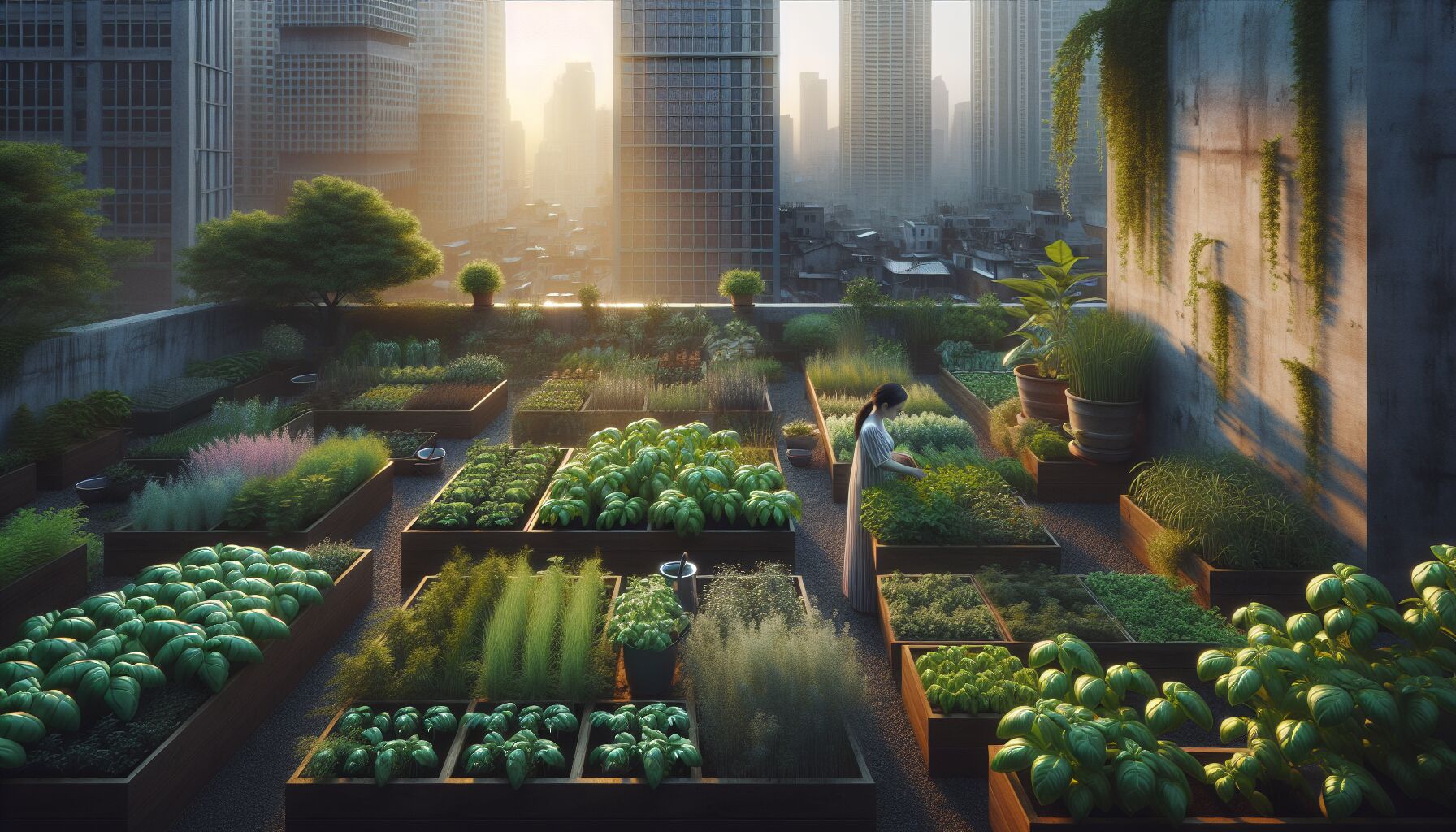 Let’s be honest—cities were never really designed with food in mind. Steel, glass, traffic, and noise crowd out soil, pollinators, and any meaningful connection to what feeds us. Yet, above all that chaos sits an overlooked opportunity: the rooftop. Quiet, sun-soaked, and often bare. And that’s where rooftop farming steps in, not as a trend, but as a return to something ancient and grounding—growing food where you live.
Let’s be honest—cities were never really designed with food in mind. Steel, glass, traffic, and noise crowd out soil, pollinators, and any meaningful connection to what feeds us. Yet, above all that chaos sits an overlooked opportunity: the rooftop. Quiet, sun-soaked, and often bare. And that’s where rooftop farming steps in, not as a trend, but as a return to something ancient and grounding—growing food where you live.
Rooftop farming isn’t just about adding greenery for aesthetics or harvesting the occasional tomato. It’s a subtle but radical shift in how we think about urban life and food production. It creates space—both physical and mental—for sustainability to actually take root in dense environments that often feel beyond repair.
So, why does it matter?
For one, rooftop gardens directly contribute to city sustainability. By producing food locally, we cut down on carbon-heavy transportation and packaging, which most people forget is one of the main ecological costs of conventional agriculture. According to the U.S. Department of Energy, food transportation accounts for nearly 10% of all greenhouse gas emissions in the supply chain. Imagine shaving that number down by simply growing lettuce above your head.
But the benefits go deeper. Think temperature control: cities absorb heat like a sponge—black roofs, asphalt, and concrete all swell under sunlight, making temperatures soar. Plants flip that equation. A well-designed rooftop farm can reduce the heat island effect, cooling the building underneath and reducing the need for air conditioning. That’s real cost savings for building owners—and relief for residents trying to survive record-breaking heat waves. It’s almost poetic—plants cooling what concrete overheated.
Let me explain another overlooked win: water management. Most cities treat rain as a waste product—funnel it off the roof, into the gutter, down the storm drain. But living soil and garden beds absorb that water, filter it, slow it. Rooftop farms keep it from overwhelming storm systems and minimize runoff pollution. That’s why architects who build for resilience often include green roofs—not just for aesthetics, but for the very practical task of reducing water challenges.
There’s also this underrated benefit—mental health. You don’t really realize how hungry your brain is for green things until you start spending 20 minutes on a rooftop with bees, basil, and breeze. Gardening literally changes your biochemistry. Researchers at NCBI found that exposure to soil microbes like Mycobacterium vaccae may act like natural antidepressants by stimulating serotonin production. Growing your own herbs isn’t just quaint—it’s medicine.
“A society grows great when old men plant trees whose shade they know they shall never sit in.” — Greek proverb
The same applies here: rooftop farming asks us to think bigger than a season, a yield, or a photo-op. It’s about stewarding a living system above the city’s shoulder, nurturing something that feeds more than our bodies.
And let’s not overlook community. A shared rooftop farm turns isolated apartments into extended households. Neighbors who might never speak start trading kale, composting together, or swapping seedlings during planting season. And that unspoken human warmth—the return of village life, scaled to modern architecture—is possible without leaving the building.
Now, of course, all this might sound idyllic until someone says, “But what about the structural load?” That’s where things get tangible. Before you plant as much as a pepper plant, an engineer needs to weigh in. But more on that in the design section.
Still, the deeper truth remains: we’re starving for meaning as much as we are for nutrition. Rooftop farming offers a small, stubborn act of rewilding in a built-up world. It feeds us in more ways than one, and at its core, it reminds us we’re still part of nature’s rhythm—even if we’ve built ourselves above it.
Whether it’s providing local food, improving city microclimates, or simply offering a handhold back to sanity, the benefits of rooftop farming aren’t just “nice-to-haves.” They’re essential responses to a world out of balance—and a quiet step toward restoring it.
Designing an efficient rooftop garden
Let’s start with the foundation—literally.
Before a basil sprout kisses the morning sun, you’ve got to know what your roof can actually hold. Back in architectural school—or during late-night YouTube black holes—you may’ve heard the term “dead load.” That’s the weight the structure was built to handle, including the roof itself. Now add in soil, water, plants, containers, mulch, maybe even a chicken or two: all that becomes “live load.” Which means one thing if you’re serious about rooftop farming—get a structural assessment. Not later. First.
Most flat roofs are already slanted slightly for drainage, but weight distribution on such surfaces can be tricky. We’re talking water retention mats, modular beds, walkways, and potentially raised walkways to preserve membrane integrity. If you’re renting, you’ll need landlord permissions; if you own, call in a civil or structural engineer, especially if you’re thinking of a large-scale food production system. There’s no shame in starting small—a few lightweight containers with herbs and spinach can teach you more than a dozen diagrams from the internet. Start with simplicity, grow with clarity.
Now let’s talk layouts, because nature doesn’t necessarily love straight lines, but humans often do. Sun is the big boss—rooftop farms typically get more direct light than any backyard. But too much sun during summer can roast tender greens. You’ll want to create layers: low-growers like lettuce or thyme in front, taller or vining crops such as pole beans or cherry tomatoes in the back—or even growing up vertical supports. Add reflective elements like white-painted trellises or heat-tolerant perennials to help manage sun exposure and stretch growing seasons.
“The best fertilizer is the gardener’s shadow.” — Chinese proverb
In other words, spend time up there. Observe. Listen. Don’t treat design like a one-and-done. Let your garden teach you.
Water comes next—your most precious ally or your trickiest limitation. You can’t rely on hauling buckets up flights of stairs unless you’re courting a back injury. Consider drip irrigation connected to a rain barrel reservoir or a roof-fed storage tank. There are ultra-efficient systems on the market now—some with solar-powered timers—that will give your plants what they need while you’re chasing deadlines or healing from burnout inside. And if you’re truly building with city sustainability in mind, graywater systems can be integrated (pending local codes) to reuse sink or shower water for irrigation—a powerful closed-loop signal that your roof has become more than spare real estate.
Soil, you ask? Don’t skimp. Container or raised-bed quality mix should be light but nutrient-rich—often a blend of coco coir, perlite, worm castings, compost, and aged bark. Avoid using native clay-heavy soil unless you’ve amended it extensively. Commercial mixes like FoxFarm’s Ocean Forest or even more local blends from compost cooperatives are great places to start. If you’re scaling up, you’ll want to check the pH and texture of your mix every couple months. Healthy soil is alive, and rooftop conditions—sun exposure, wind, container drying—can disrupt its ecosystem faster than you’d expect.
And don’t ignore wind. On roofs, wind is often stronger than it feels at street level. Install windbreaks—bamboo screens, lattice walls, even tightly woven nets—to shield your crops while still allowing good air circulation. Some plants can take the stress (like kale); others, like cucumbers or basil, need more protection to thrive. Think resilience, not just appearance.
Here’s where it gets quiet but crucial—what’s your intention up there? Is it for personal nourishment, community food production, or educational outreach? The design should reflect that. A solo space may need seating, nooks for rest and reflection. A neighborhood project? Think shared tools, teaching beds, room to gather. Your why shapes your farm’s how.
Don’t be afraid to blend beauty with function. Edible flowers, colored chards, golden zucchini—these cues invite wonder and deepen connection. After all, you’re not creating a factory. You’re stewarding a tiny piece of Earth that just happens to float above traffic.
Space management also makes or breaks a rooftop garden. Here are a few easy-to-forget details folks usually miss:
- Access and safety: Make sure crew, family, or occasional volunteers can get up (safely) and get around (efficiently). Protective railings or secured fencing is a must in most city codes.
- Storage matters: You’ll need bins for compost, spots for tools, seed trays, and possibly refrigeration if you’re distributing food.
- Vertical elements: Arches, espaliered trees, or simple pallet walls can triple your growing surface when horizontal room runs out.
Here’s the trick: think like water. Flow around constraints. Fill what’s available. Support what wants to grow upward.
And yes—expect some setbacks. A late frost, aphids clinging to kale, or rooftop squirrels that apparently think they’re gods. But nothing real is without friction. The act of designing this space—thoughtfully, practically, even lovingly—is part of the healing. Not just personal healing, but ecological restoration. A feed loop between you and the land, even if it’s thirty feet in the air.
The urgency of city sustainability doesn’t mean frantic action—it means steady, grounded building. And what’s more grounded than laying beds of living soil on a rooftop in the heart of a busy city?
There’s one more secret: spaces made well invite people in. And people, when they belong somewhere, become protectors of it.
So don’t rush. Let your rooftop farm emerge like a season—imperfect, surprising, and exactly enough.
Maintaining and scaling your rooftop farm
 Maintenance isn’t maintenance when you do it daily—it’s rhythm. Like sweeping your porch, brushing your teeth, or feeding the dog. Rooftop farming, for all its promise, only continues working if it becomes part of your life’s cadence. Not a dramatic side project, not a pretty photo shoot, but an honest part of the week—quietly feeding you while you feed it back.
Maintenance isn’t maintenance when you do it daily—it’s rhythm. Like sweeping your porch, brushing your teeth, or feeding the dog. Rooftop farming, for all its promise, only continues working if it becomes part of your life’s cadence. Not a dramatic side project, not a pretty photo shoot, but an honest part of the week—quietly feeding you while you feed it back.
Let’s start with the basics: if your rooftop garden is even halfway established, then you’re already juggling light exposure, watering cycles, nutrient balance, pest pressures, and microclimates. Consistency, not perfection, is gold here.
Most rooftop growers benefit from developing a weekly checklist—nothing rigid, just a simple rhythm:
- Water system check: Drip lines clog. Timers fail. Cisterns crack in winter. Run a weekly inspection to catch small issues before they become soggy pandemics.
- Leaf language: Yellowing tips? Curling leaves? Silent distress often shows up this way. Take 10 minutes and just walk around with no tools—observe first, then act.
- Compost rotation: Your rooftop fertility source is likely small-scale. Stir it. Feed it greens and browns. Pay attention to smell—good compost should be earthy, not sour.
Some growers install simple sensors—like moisture meters or pH sticks—to keep the guesswork down. But honestly, your hands and nose can tell you nearly everything if you let enough seasons teach you. Good rooftop farming invites that kind of listening.
Now, scaling up. That’s a different animal. You’re no longer just feeding your house—but perhaps your apartment building, CSA batch, or local co-op. That shift from personal resilience to shared abundance changes everything. Suddenly you need structure, and yes—maybe spreadsheets.
1. Systems over hustle: Scaling up doesn’t mean stretching yourself thinner. It means gearing up smarter. Build systems that do the remembering for you—automated irrigation, shared calendars, modular hauling crates, and crop maps for succession planting. Think like nature—patterned, responsive, efficient without rushing.
2. Partnerships matter: Look beyond your rooftop. Is there a chef in the building who’d trade compost scraps for a weekly salad mix? Do nearby schools or churches want to volunteer during planting season? Scaling doesn’t have to mean growing every leaf yourself. It often means growing the circle of folks involved.
3. Crop choice evolves: When moving toward steady food production, you’ll favor crops that are reliable, high-yield, and relatively pest-resistant. Leafy greens like arugula or tatsoi grow fast. Herbs stretch into multiple harvests. Cherry tomatoes give and give, provided stakes keep up. Save the exotic for corners where curiosity thrives—but keep bulk production straightforward.
Every city has its quirks—Baltimore’s rooftop heat is not the same as Portland’s moisture swings. But the deeper rhythms of rooftop tending don’t change. You rotate crops like good conversation—knowing when to let go and when to reseed. You track airflow like a sailor. You accept failure without drama. And the more you scale responsibly, the more the garden teaches you about thresholds—what feeds you, and what feeds the others around you, without burning the soil.
Here’s a truth whispered by those who’ve worked land long enough: everything you build needs downtime. Even a rooftop farm needs to sleep. Winterization may mean laying down straw mulch, trimming back perennials, or simply letting containers rest after a long season of giving. Don’t resist that cycle. Rest restores resilience.
Some folks resist expanding because it feels like “selling out” or turning something intimate into industry. But remember: sacredness isn’t measured by size—it’s measured by intention. A rooftop farm that produces 300 pounds of lettuce for a local kitchen can carry just as much soul as one tomato plant grown by a grieving heart.
Scaling is just another word for navigating growth. The question is: will your growth still stay rooted?
“He who plants a garden plants happiness. If he plants it with care, he grows hope.” — Lebanese saying
Food production, especially in dense cities, doesn’t just supplement grocery needs—it rewires how we relate to place, season, and possibility. As more people touch soil, understand weather not as inconvenience but as kin, rooftop farming is no longer a novelty. It becomes a quiet infrastructure—a backbone in the slow movement toward city sustainability.
The nuts and bolts remain grounded: pest management (try neem or beneficial nematodes), season extension (simple row covers work wonders), and record keeping (rainfall logs, harvest journals, plant photos on your phone). But more than that, it’s about honest stewardship. How much can you maintain without burnout? Who can you train to help? Where does the next yield go?
Whether you’re 100 square feet or 1,000, remember: “more” isn’t the only measure. Sometimes maintaining one thriving raised bed, cared for year-round, teaches you more about abundance than pumping out baskets of kale in a scramble.
As the garden scales, let it teach you scale—of care, of impatience checked, of relationships that deepen through shared labor. Keep one thing true: let the rooftop stay a place of reverence, not just production. That’s where its power lies.
 DS Haven In Light Of Things
DS Haven In Light Of Things






